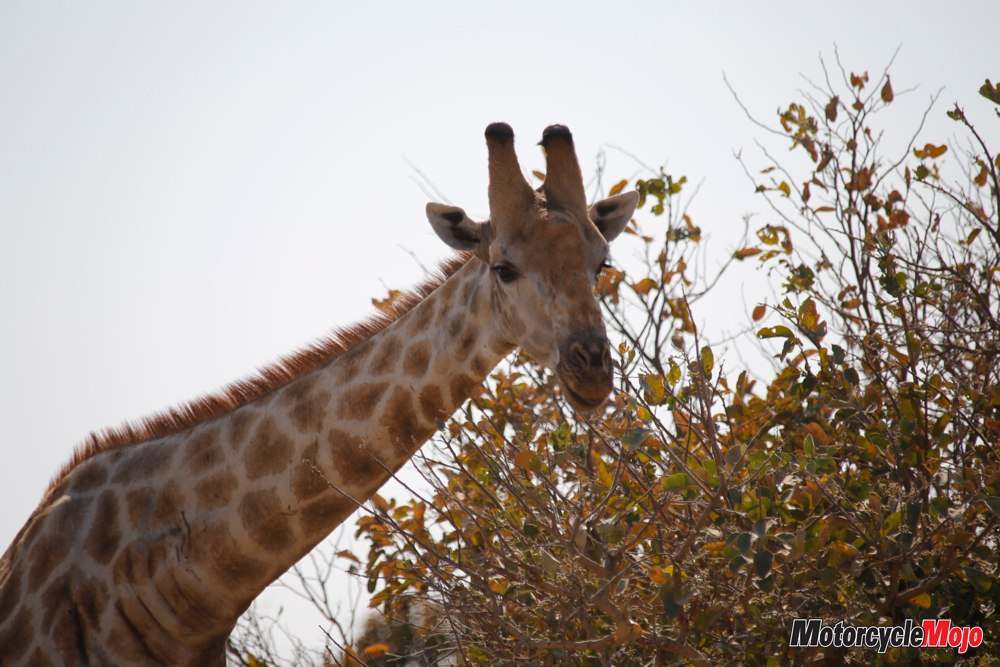Twenty people on 15 motorcycles take off on a 3000 km African adventure to experience one of the world’s seven natural wonders and a look at an amazing culture
Our first day of riding on this two-week Wildlife and Waterfalls tour embraced us with clear skies and sunshine. This early-August adventure took us into three African countries – Namibia, Botswana and Zimbabwe – and the riding temperatures were perfect, given we were just entering springtime in Africa. The day started out at just 15 C when the 14 BMWs of various sizes and a single KTM left the Klein Windhoek Guest House in Windhoek, Namibia, but within an hour or so the temperature had risen to 28. My wife, Gwen, and I along with our crew of adventurers headed due east toward the vast Kalahari Desert. Rene Cormier, owner of Renedian Adventures, would lead our group, South African Du Toit van Niekerk would ride at the back of the pack on his KTM 990 Adventure, while Henk van Niekerk from Zulu Overland would follow in the chase vehicle with our luggage, spare bike, parts and tires.
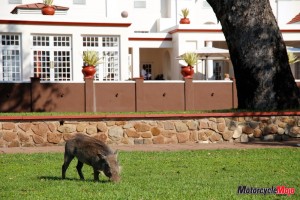 Our day’s ride ended just east of the Namibian town of Gobabis at the Zelda Guest Farm. This Renedian Adventures tour comprised 99 percent pavement; Zelda’s 2.5 km gravel and sand driveway represented a portion of the remaining one percent. Zelda’s resident warthog was there to greet us as we pulled up to the main entrance. He isn’t friendly enough to pet, but he does sleep under the reception desk.
Our day’s ride ended just east of the Namibian town of Gobabis at the Zelda Guest Farm. This Renedian Adventures tour comprised 99 percent pavement; Zelda’s 2.5 km gravel and sand driveway represented a portion of the remaining one percent. Zelda’s resident warthog was there to greet us as we pulled up to the main entrance. He isn’t friendly enough to pet, but he does sleep under the reception desk.
While at Zelda, our group of 18 adventurers piled into a modified Bedford truck-turned-safari-vehicle for a trip into the savannah to visit a tribal village of the Nharo bushmen. We were met by a multi-generational family who then walked us into the savannah and proceeded to explain their culture and daily life, as well as how to live off the land. They also showed us what to watch for in the desert, including plants that will kill you if you’re not careful.
The Kalahari is a semi-arid desert that covers about 900,000 sq. km in parts of Namibia and South Africa, and consumes about 70 percent of Botswana. With limited rainfall, the Kalahari is able to support livestock and wildlife, and we were forewarned of this crossing into Botswana.
Immediately evident was the lack of fences at the side of the 125 km/h highway – and there is plenty of free-range livestock. The verge at the side of the road, however, is cleared back about 25 metres, so spotting animals in the distance is not a problem. Experience will teach you though that it is the young, skittish ones to watch out for, while the older ones might simply lift their heads to watch you pass as they stand on the centreline, or in the middle of your lane.
This is the second Renedian Adventures tour Gwen and I have been on, and was quite different from the Spectacular South West Africa tour we participated in last year, which was 40 percent gravel. The roads on this journey were flatter and many of them were arrow-straight. But with paved roads comes potholes, and some on Botswana highways were large enough to almost swallow a motorcycle.
Ditch the Bikes for a Plane
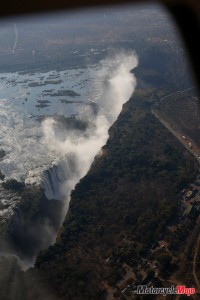 One of the many highlights of this trip was a 45-minute chartered flight over the Okavango Delta to our next night’s accommodation at a tented camp in the Moremi Game Reserve. The 18 of us boarded four small aircraft and flew at 500 feet. We were treated to sights straight out of a National Geographic film as we flew over herds of elephant, water buffalo, giraffe, hippo and countless antelope before touching down on a small gravel landing strip in the middle of the delta.
One of the many highlights of this trip was a 45-minute chartered flight over the Okavango Delta to our next night’s accommodation at a tented camp in the Moremi Game Reserve. The 18 of us boarded four small aircraft and flew at 500 feet. We were treated to sights straight out of a National Geographic film as we flew over herds of elephant, water buffalo, giraffe, hippo and countless antelope before touching down on a small gravel landing strip in the middle of the delta.
Before settling into the bush camp for the night, we enjoyed a game drive where we encountered a variety of wildlife, including elephants that were so close you could distinguish each wrinkle around their eyes, and hippos near enough to count their teeth when they yawned. It was a photographer’s dream. Just before reaching the bush camp, we were fortunate to see an astounding sunset on the savannah. Having been in Africa twice now, I can honestly say the African sunsets are unlike anywhere else – words and photos cannot do them justice.
We arrived at the camp to find the tents and tables (complete with place settings) set up by Swampland Tented Safaris. The food was plentiful and simple, yet outstanding in so many ways – rugged elegance on the African savannah. During the evening we were warned not to venture far from camp. It’s a life-and-death struggle for most animals and there could be predators lurking in the shadows; wandering too far might mean life-and-death for a human as well.
Sleeping on cots didn’t allow for rolling over, but it did provide an entertaining symphony of snoring. We were told in the morning the noises that weren’t humans snoring were hyenas, lions, elephants, and hippos that were only 500 metres away at the river.
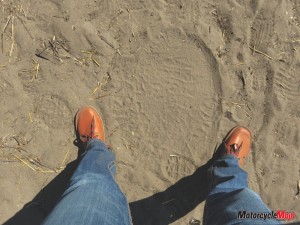 Owing to a vehicle breakdown, we had been split into two groups for the morning’s game drive. While we were out, the others had the opportunity to witness six elephants meander through the camp, one of them taking out the men’s outhouse; luckily no one was in it. Upon returning, I roughly measured one of the footprints in the sand and it was about 40 x 60 cm – unbelievable. Two weeks prior, Henk was preparing lunch when a pride of lions walked through the camp.
Owing to a vehicle breakdown, we had been split into two groups for the morning’s game drive. While we were out, the others had the opportunity to witness six elephants meander through the camp, one of them taking out the men’s outhouse; luckily no one was in it. Upon returning, I roughly measured one of the footprints in the sand and it was about 40 x 60 cm – unbelievable. Two weeks prior, Henk was preparing lunch when a pride of lions walked through the camp.
Instead of flying out of the delta, we drove back to Maun in safari vehicles, and after a single-lane detour for several kilometres through the bush in deep, talcum powder-like sand because of a washed-out bridge, we made it back to our bikes and our accommodations for the night. Interestingly, the sides of the road on the way back looked as if a twister had gone through and uprooted trees, when in fact it was elephants that had knocked them over.
Veterinary checkpoints are common on all major highways in Botswana to help curb foot and mouth disease. In the last couple of days, we’d experienced these checkpoints from the extreme to the bizarre. At one, we had to ride our bikes through a bath of disinfecting fluid and step on wet towels doused with the same fluid to disinfect the soles of our boots. Oddly, we had stopped at a checkpoint in the safari vehicle just a day before, and although we had to step on the wet towels, the attendant, armed with only a hand wand, sprayed only the top half of the vehicle’s tires, with no concern for the bottom half.
More than Just Cows and Donkeys
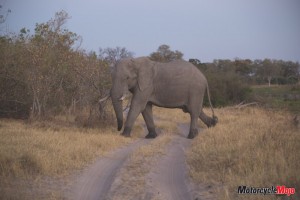 On the way to our well-appointed, spacious chalets at the Nata Lodge, we passed an elephant on the side of the road, as well as giraffes and kudus – I could never get bored of seeing these majestic animals in their natural habitat. We also had our first introduction to grass fires and the amazing baobab tree.
On the way to our well-appointed, spacious chalets at the Nata Lodge, we passed an elephant on the side of the road, as well as giraffes and kudus – I could never get bored of seeing these majestic animals in their natural habitat. We also had our first introduction to grass fires and the amazing baobab tree.
Grass fires are purposely set by farmers to clear the dead groundcover so new growth can begin. The grass burns so fast that there is no threat to trees or buildings, but it can spread quickly and burn many acres in no time. The fire we rode past was on both sides of the road. The baobab trees are unique in that they look as if they’re growing upside down – the branches look like roots – and the massive trunks hold enough water to still produce fruit during a drought.
From the Nata Lodge, our destination was through the Chobe National Park to the town of Kasane, near the Zimbabwe border. (Canadians need a visa to enter Zimbabwe, so before leaving for Africa, Gwen and I had to send our passports along with $100 each to the Zimbabwe Embassy in Ottawa.) The paperwork our group would need to get our bikes into Zimbabwe and out the next day promised to be too much of a hassle, so everyone left their bikes at the Water Lily Lodge in Kasane and boarded vans to take us into Zimbabwe to Victoria Falls.
While on the outskirts of Kasane, we had to stop to allow a herd of elephants to cross the road. Once underway again, we noticed a schoolyard that used to have heavy steel fencing supported by large stone and cement pillars. Most of the steel was lying on the ground – pushed over by elephants, according to our driver. Every day is a memory maker Whether it’s the resorts, the food or just the experience of riding in Africa, Rene goes to great lengths to make his tours memorable, and staying at the Victoria Falls Hotel is the epitome of extreme opulence. Serving royalty and dignitaries, and apparently bikers, for over 100 years, this over-the-top piece of Victorian history has fully mature trees in the inner courtyard. The resident warthog – yes, another one! – eating grass beside the restaurant patio is a memory in itself, as are the monkeys and baboons that call the property home. Victoria Falls, one of the seven natural wonders of the world, is only a 15-minute walk from the hotel along a wooded path. Making it one of the seven wonders is a curtain of water that stretches almost two kilometres long and plunges 108 metres into the gorge far below.
That’s more than twice the height of Niagara Falls. In the rainy season, more than 500 million cubic metres of water flows over the edge every minute. Far different from what we’re used to in over-regulated North America, common sense prevails, as many of the look-offs don’t have guardrails, just signs to be careful of slippery rocks. We thought the people with rain ponchos were a little overzealous, until we found an area where the crashing falls plummeted into the gorge with such force and created such a mist that it was like standing in pouring rain – we were instantly soaked. It’s said that the mist can be seen from 30 km away. Viewing the falls from land is one thing, but to really get a true perspective of its size, you need to see it from the air, as we did the next day in a helicopter. Other options for our non-riding day were elephant rides, the world’s longest bungee drop above the Zambezi River and walking with lions . . . and petting them – I kid you not. Once back in Kasane at the Water Lily Lodge, we boarded a riverboat for a three-hour cruise on the Chobe River, during which we spotted crocodiles, elephants by the hundreds, hippos, water buffalo, baboons, large numbers of various antelope and a wide variety of birds.
Another spectacular African sunset completed our day on the Chobe. Next Wicket, Please It took about an hour to cross back from Botswana into Namibia. After collecting the paperwork at one wicket, we had to take a slip of paper, which had been given to each rider, to another wicket two metres away. It appears this person’s sole job is to stamp the back of the slip of paper without even looking at it and hand it back to you. In addition to that slip of paper, and your passport, more paperwork with your bike’s engine number and VIN had be filled out again at the police checkpoint across the parking lot before crossing into Namibia’s Caprivi Strip. Seems like a huge make-work project. As one fellow rider commented, “It seems a little Monty Python-ish.” I couldn’t have agreed more. Going Back in Time Nothing about the Caprivi Strip seemed modern, and I saw rural Africa as I had imagined it: small settlements containing a grouping of round huts made from mud and cow dung walls with thatched roofs.
A perimeter wall made of vertical sticks tied together surrounded the settlements; its sole job, we were told by a tribesman, was to keep lions out. Along the highway we saw several women carrying bottles to refill at large water tanks that might be many kilometres away. “Africa runs on the backs of women,” replied Rene, after I commented on how I saw a woman carrying a large sack in one arm, a baby in the other and a basket balancing on her head while a man, I assumed her husband, walked empty-handed beside her. Throughout our whole trip, kids would run to the roadside in bare feet, sometimes just wearing minimal clothing, excitedly waving and cheering as we passed. They don’t see many motorcycles here. In fact, we had yet to seen any bikes on the tour, with the exception of a couple of scooters in Victoria Falls and a few motorcycles in Windhoek.
At one of our lunch stops, Henk gave three little boys some of our food in a plastic bag. They sat in the sand a few metres away and enthusiastically ate, and seemed just as enthusiastic about the bag. Another time, Gwen and I and Tom and Ann (long-time friends who were also on the trip) stopped to give a large group of kids some pencils and pads of paper we had brought over with us. In no time, children swarmed Gwen with their hands out reaching for gifts. It was pretty cool to see the kids’ eyes light up at times like those. We stopped riding at Nunda River Resort, located on the Okavango River, which serves as the border between Namibia and Angola. Sitting on the resort’s deck, we enjoyed a beer and let the cool wind from the river wash away the 33 C heat we were riding in all day. Hippos were also enjoying the cool water and shoreline not far from us. After dropping the bags off at our well-appointed permanent tent, I ventured down to the river for a closer look. When I heard weeds rustling ahead of me, I remembered learning that hippos are the most dangerous animals in Africa, killing more people than any other wildlife. It didn’t take me long to move to higher ground. We finally saw some mountains the next day – and a break from the arrow-straight, flat roads – before arriving at the luxurious Mokuti Etosha Lodge.
As we left our ground-level room for dinner, there was a herd of black-faced impala on the grass right outside our door, and the next morning we had about 50 banded mongoose chasing one another around. One almost got in our room, but I closed the screen door just in time. The next day we drove into Etosha National Park. Motorcycles aren’t allowed in, so safari vehicles transported us to Taleni Etosha Village, on the south end of the park. Both Taleni and Mokuti offer outstanding accommodations and food. In Africa, all animals are considered food, and it’s at places like this that you’re able to try a wide variety of two- and four-legged beasts. Great if you’re a meat eater, not so much if you’re a vegetarian. For the next two days, while we were on game drives or relaxing at the pool, Henk and Du Toit were busy loading our bikes on the trailer and making multiple trips as they delivered them to our new digs on the other side of the park. Seeing elephants, giraffes, kudus, oryx and a hundred other species in their natural habitat was one thing, but seeing a pride of lions was extra special.
Africa’s lion population has decreased 80 to 90 percent over the past 20 to 30 years, so we were lucky to have watched a male, five females and three cubs at one of the watering holes. Living from One Extreme to the Other We spoke to a bartender at Mokuti who lives in one of the remote villages and travels here to work. He’s just one of thousands who don western clothing to work for a couple of months straight, head back to tribal life for two weeks, and then return once again to work. He mentioned how his culture cannot fathom the extremes and indulgences that Westerners and Europeans live by – the cost for us to enjoy these lavish resorts, the size of the buffets and the cost for us to get here. We later learned that Eddie, one of our game-drive guides in Etosha, is from the Himba tribe, and on his time off he rejoins his tribe and once again lives as if it were a thousand years ago; I swear the man could track a mouse. Ishmael, another one of our guides and also a tribesman, told us that the dowry in some tribes still involves livestock, and the father of the bride picks which animals he’s to receive. If you aren’t rich enough to own healthy livestock, you don’t get the girl. The last day of the tour was our last riding day as we left Etosha and headed back to Windhoek some 400 km distant.
It was a bittersweet end to an amazing two-week, 3000 km adventure. I can’t say enough about the accommodations and the food, and the bikes ran perfectly – every aspect of Renedian Adventures tours is top-notch. The prices vary depending on the tour, but they all include your bike, all dinners and breakfasts, most lunches, park fees, game drives, tolls, airport transfers and so much more. And I have to throw a huge thank you out to the men who looked out for us in the bush camp, and especially to Rene, Du Toit and Henk for their knowledge, humour and just being great guys to hang out with for two weeks.









